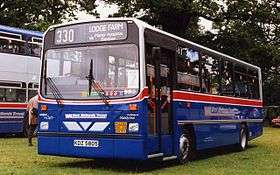Wright Handybus
| Wright Handybus | |
|---|---|
 West Midlands Travel Handybus bodied Dennis Dart in 1995 with flat driver's windscreen | |
| Overview | |
| Manufacturer | Wrightbus |
| Production | 1990–1995 |
| Assembly | Ballymena, Northern Ireland |
| Body and chassis | |
| Doors | 1 door |
| Floor type | Step entrance |
| Chassis |
Dennis Dart Leyland Swift |
| Powertrain | |
| Engine | Cummins B-series (Dennis Dart) |
| Capacity | 29 to 37 seated |
| Dimensions | |
| Length | 8.5m, 9.0m and 9.8m |
| Width | 2.52m |
| Height | 3.02m |
| Chronology | |
| Successor | Wright Crusader |
The Wright Handybus was a single-decker bus body built primarily on the lower floor Dennis Dart chassis, that form it had a lower floorline, by Wrightbus between 1990 and 1995. It was also built on a small number of the higher floor Leyland Swift chassis, in which form it had a higher floorline. It has a bolted aluminium structure with two alternative windscreen styles.
The outward styling is quite plain, with a flat front. Two alternative windscreen styles were offered; some vehicles had a single-piece flat windscreen with an arched top, whilst others had two separate flat windscreens with that on the driver's side raked back, reminiscent of some 1950s single-decker buses and the Leyland Lynx.
London Buses was the first and also the largest customer, buying a fleet of nearly 200 Handybus-bodied Dennis Darts.[1] Go-Ahead Northern also bought over 80, and Ulsterbus and Citybus had 40 between them.
See also
References
- ↑ Dennis Dart: the first Generation Ian's Bus Stop
| Wikimedia Commons has media related to Wright Handybus. |